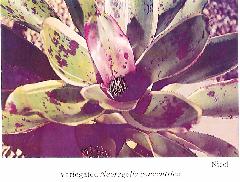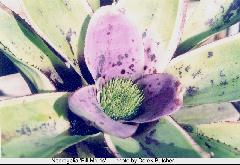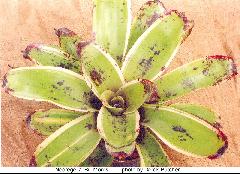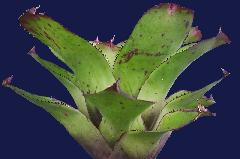
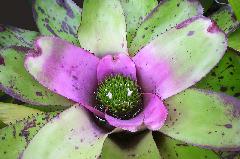
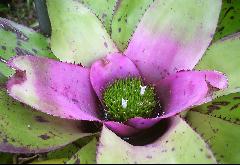
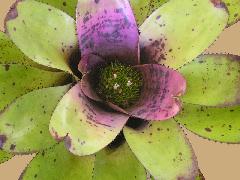
Desc from S&D
Plant usually large, propagating by stout basal rhizomes.
Leaves 7-30 in a dense broadly funnelform rosette, 20-40 cm long;
Sheaths large, broadly elliptic, entire, covered on both sides with appressed pale brown scales;
Blades ligulate, broadly rounded and apiculate, 5-10 cm wide, wholly green or with dark purple spots above or the inner leaves at times wholly purple, pale lepidote especially beneath, usually densely serrate with stout black spines to 4 mm long.
Inflorescence sunk in the center of the rosette, many-flowered;
Outer bracts broadly ovate, rounded and apiculate, exceeded by the sepals, entire, pale, membranaceous, lepidote toward apex.
Floral bracts linear, broadly acute or rounded and apiculate, more or less incurved toward apex, slightly exceeded by the sepals, entire, ecarinate, submembranaceous, pale green, sparsely lepidote;
Pedicels slender, 10-18 mm long;
Flowers 4-5(-7 ! Mez) cm long.
Sepals free or short connate, slightly asymmetric, subelliptic, long-attenuate but never pungent, 22-30 mm long, green, glabrous;
Petals acuminate, white or blue, exceeding the stamens;
Ovary slenderly ellipsoid, to 15 mm long.
Type. Vellozo s n, lost, if any specimens were ever made. Typification is on the basis of the description and plate, especially the latter. The only locality data is, “Arboribus habitat ad littora maris" and the vicinity of Rio de Janeiro is inferred by the title of the work.
Distribution. Rainforest, sea level to ca 800 m alt, Rio de Janeiro and Guanabara, Brazil.
BRAZIL. Rio de Janeiro: Petropolis, 4 Feb 1879, Glaziou 11687 (P); Serra dos Orgaos, Dec 1892, Ule 1985 (R); Teresopolis, 31 Mar 1917, Sampaio 2067 (R); 7 Jan 1959, Abendroth 104 (US); Soberbo to Guapi, Serra dos Orgaos, 18 Dec 1928, L. B. Smith 1533 (F, GH, S); Alto da Serra to Meio da Serra, 22 Dec 1928, L. B. Smith 1575 (GH, S); Barreira to Teresopolis, 9 Dec 1948, Pereira & Duarte 1591 (RB, US); old road below Petropolis, 10 Apr 1952, L. B. Smith & Mus R 6492 (F, GH, R, S); Campos, 2 Nov 1962, L. Seidel 270 (HBR); Angra dos Reis, 1 Feb 1968, L. B. Smith & McWilliams 15362 (MICH, R, US). Guanabara: Copacabana, Glaziou 15495 (BR); Sao Cristovao, cultivated (?),18 Aug 1892, Lindman A-49 (S).
Detail from Bromeliaceae, Baker 1889
22. KARATAS ACANTHOCRATER Baker in Bot. Mag. t. 6904; Antoine, Brom. t. 29 and 30, fig. 2.
Nidularium acanthocrater E. Morren in Belg. Hort. 1584, 140, t. 9 (M.D.).
Acaulescent. Leaves 20-80 in a short rosette, lorate, the outer 1˝ ft. long, 2-3 in. broad at the middle, moderately firm in texture, the face green, often spotted with dark brown, the back thinly white-lepidote, the tip rounded to a cusp, the marginal prickles large and brown.
Flowers in a dense capitulum 2-3 in. in diam. in the centre of the rosette, the reduced inner leaves dark or light purple, rarely unchanged in colour;
flower-bracts lanceolate, scariose.
Ovary cylindrical trigonous, white, 1/2 in. long;
sepals green, lanceolate-acuminate, 3/4-1 in. long.
Petals violet, protruded 1/4-1/3 in. beyond the tip of
the sepals.
Filaments shorter than the anthers.
Hab. South Brazil, Glaziou 11687 !
Introduced into cultivation by Dr. Glaziou in 1877. Described from a plant that flowered at Kew in May, 1886. Vars. Plutonis and Proserpine of Morren differ in the colour of the reduced inner leaves. Glaziou 15494 (K. macracantha Baker). Now treated as carcharodon is probably an allied distinct species. It has close spreading brown prickles .25in, and sepals 1.25 in. long.
Detail from Bromeliaceae, Baker 1889
20. KARATAS LAURENTII Antoine, Brom. 48, t. 28.
Nidularium Laurentii Regel, Gartenfl. t. 529 (M.D.).
Billbergia aurantiaca Hort.
Leaves 10-12 in a short rosette, lorate, 1-1.25 ft. long, 2-2.5 in. broad at the middle, moderately firm in texture, plain green on both sides, thinly lepidote beneath, rounded to a cusp at the tip, the marginal prickles minute, black.
Flowers in a globose head in the centre of the reduced inner leaves, which are sometimes, but not always, tinged with purple;
flower-bracts narrow, green, scariose.
Ovary white, half as long as the green lanceolate sepals, which are .75 in. long.
Petals violet, protruded .25 - 1in. beyond the tip of the calyx.
Filaments shorter than the anthers.
Hab. South Brazil, Burchell. Glaziou 15495. Introduced into cultivation about 1867. Named after Dr. Laurentius, of Leipsic. Described from a plant at Kew, March, 1877. It may be Bromelia concentrica Beer, founded upon a rough figure in the 'Flora Fluminensis' (Tillandsia concentrica, vol. iii. t. 133).




